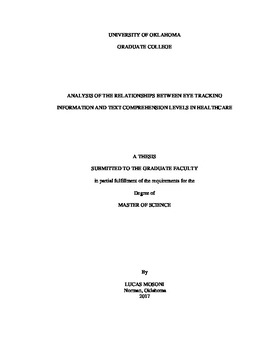| dc.description.abstract | Health information can be found more easily than ever through a variety of digital texts: from health forums online, informative websites, or phone apps that monitor your health. It is important that the patients are able to comprehend this information correctly as it can lead to important decisions regarding their health. However, the average patient will have difficulties understanding digital texts as they contain medical terminology. Reading such content requires multiple cognitive processes and memory to fully grasp the communicated information.
The data used in this project comes from an eye tracking experiment involving human subjects reading health related texts and answering questions about these texts. The eye tracking data includes information about the number of eye fixations, fixations’ durations and positions in different areas of interest of the screen. The read paragraph also had different complexities and there were different types of questions. First, a quantitative analysis involving multiple ANOVAs was performed to uncover the effect of different chosen factors. After some feature engineering guided by the previous analysis, machine learning was used to classify whether a participant would answer correctly or not using eye tracking data and variables relative to the text and questions.
The initial analysis showed that increasing levels of complexity of the digital text resulted in more eye fixations and longer reading times and that different questions provoked different reading behaviors. More importantly, the random forest classification model was successful with a 96% accuracy thanks to the engineered features, showing that human decisions can almost be predicted using only our eyes’ behaviors. | en_US |
